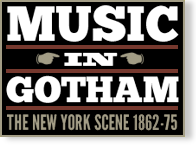Church of the Holy Communion Organ Exhibition
Event Information
Venue(s):
Church of the Holy Communion
Event Type:
Chamber (includes Solo)
Record Information
Status:
Published
Last Updated:
7 April 2025
Performance Date(s) and Time(s)
12 Dec 1873, EveningPerformers and/or Works Performed
Citations
“The organ built for the Church of the Holy Communion was formally opened last night by a number of organists, who played before a large audience of invited guests.
The instrument is built by H. L. Roosevelt, who has introduced therein, among other modern improvements, an invention of his own, called the ‘electric melody organ,’ so devised as to render the melody exceedingly prominent, and thus give especial aid to congregational singing.
[Lists participating organists.]
The instrument is rich and melodious in tone, and in every way a desirable addition to the list of first-class organs with which this city is favored.
The following is the schedule of stops: [lists stops].
Four couplets and five combination pedals complete the facilities of the instrument.”
“A new organ, built by Mr. Holborne L. Roosevelt, was exhibited last night at the Church of the Holy Communion, corner of Twentieth st. and Sixth-ave. we believe it is the first large work of a young builder who has for some years been well known in musical circles for his enthusiastic devotion to this branch of the art. He has studied his favorite instrumental carefully, both at home and abroad, and endeavors to combine the best points of the French, German, and English schools, with some improvements of his own devising. The organ displayed last night has three banks of keys, besides the pedals; but, in place of the customary ‘choir organ,’ Mr. Roosevelt has introduced a novel invention which he calls the ‘Electro-Melody Organ,’ designed especially for the accompaniments to congregational singing. By a curious adaptation of the electric action this is so arranged that the upper note of every chord is heard above the rest of the harmony. The melody is thus so distinctly indicated that an untrained chorus can have no difficulty in catching the air, and in the performance of voluntaries the arrangement can be made to take the place of a solo stop. The following is the scheme of the instrument: [lists stops]. There are also four couplers and five combination pedals.
The instrument is remarkable for purity and brightness of tone, and a most musical [voicing?]. The fine quality of the trumpets and other loud stops was the theme of general admiration; the gambas also were brilliant and effective; and the reels (which we understand were made in France) were all delicate and sympathetic. It is very uncommon to hear an organ in which so much brilliancy is combined with so much sweetness. We did not detect one harsh stop. The instrument is perhaps not so rich in the variety of registers as many others in New-York; but the distinct coloring of each stop is well preserved. The softer ones are exquisite, and although we missed something of the large, full, noble tone which belongs to the diapasons and chief pedal stops in some other organs, the instrument seems to be, upon the whole, well balanced.”

